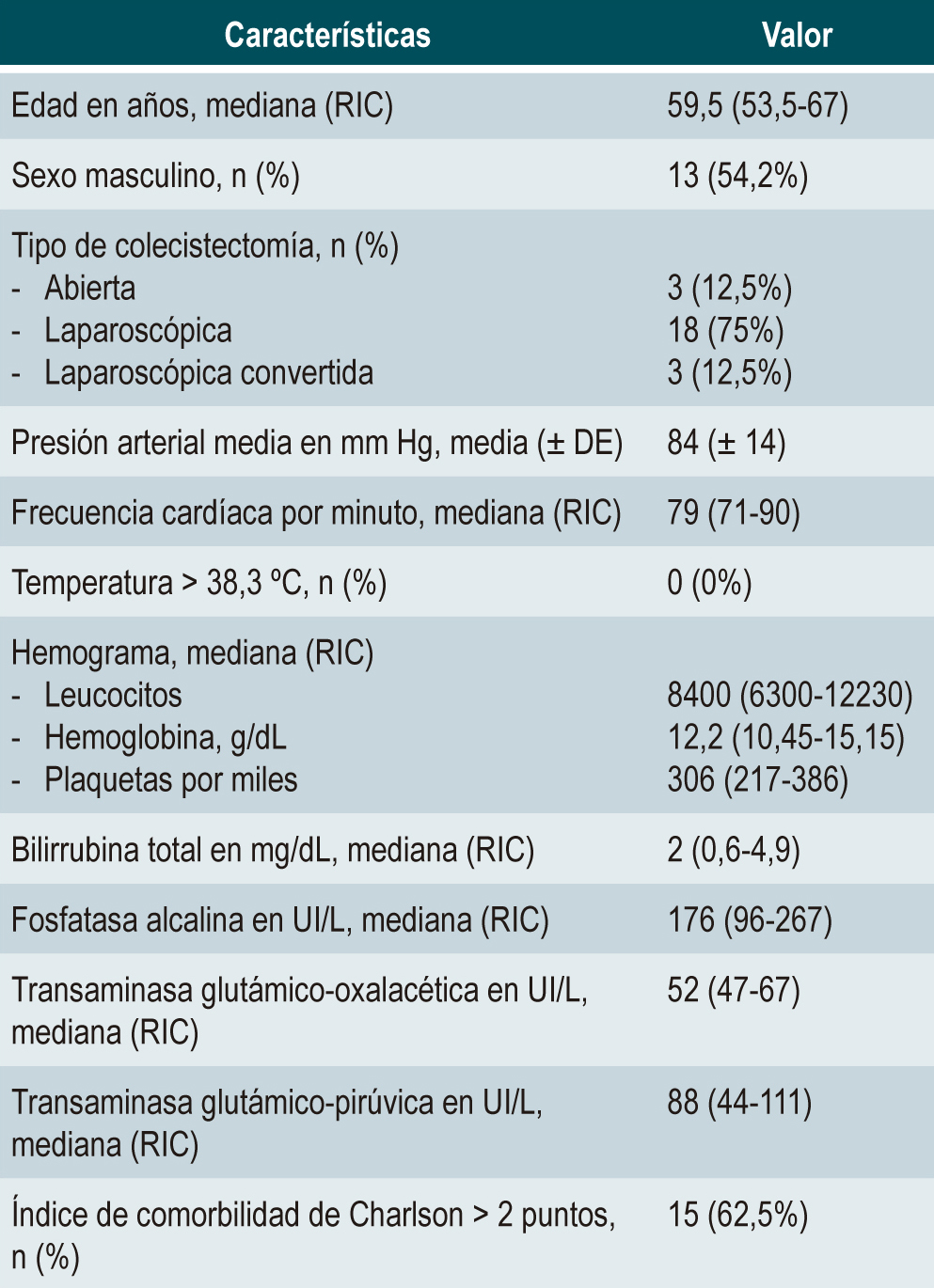Experiencia del manejo por colangiopancreatografía retrógrada endoscópica de las fístulas biliares poscolecistectomía en un hospital de referencia en Colombia
DOI:
https://doi.org/10.22516/25007440.905Palabras clave:
Fistula biliar, Papilotomía, CPRE, Prótesis biliarResumen
Introducción: la fistula biliar poscolecistectomía es poco frecuente. El manejo principalmente es endoscópico, pero en la literatura no hay consenso en la técnica de primera línea entre papilotomía, prótesis biliar o su combinación.
Metodología: se realizó un estudio observacional tipo serie de casos en el que se incluyeron todas las CPRE realizadas en el Hospital Universitario San Ignacio en Bogotá, Colombia, entre enero de 2010 y marzo del 2021 por fistula biliar posterior a colecistectomía. Se registraron las características demográficas, manifestaciones clínicas, resolución, eventos adversos y estancia hospitalaria según la técnica endoscópica.
Resultados: se incluyeron 24 pacientes con fistula biliar poscolecistectomía que se manejaron con CPRE. La mediana de edad fue de 59 años (rango intercuartílico [RIC]: 53,5-67). En el 75% el tipo de cirugía fue laparoscópica. La manifestación clínica más frecuente fue aumento del drenaje biliar > 150 mL/24 horas (50%), seguido de dolor abdominal (39%). La principal localización fue el conducto cístico en el 40%. El manejo con papilotomía fue del 25%; con prótesis biliar, 8,4%, y combinado, 66%; la resolución de la fístula ocurrió en el 100%, 50% y 87%, respectivamente, con menor estancia hospitalaria en el manejo combinado de 3,5 días frente a 4 días en papilotomía. Solo se presentó 1 evento adverso de hemorragia en el grupo de papilotomía.
Conclusión: la papilotomía y la terapia combinada son opciones terapéuticas con buenas tasas de resolución y baja estancia hospitalaria para el manejo de las fistulas biliares poscolecistectomía. Se requerirán estudios prospectivos, aleatorizados y multicéntricos para definir la técnica con mejores desenlaces clínicos.
Descargas
Referencias bibliográficas
Everhart JE, Ruhl CE. Burden of digestive diseases in the United States part III: liver, biliary tract, and pancreas. Gastroenterology. 2009;136(4):1134-1144. https://doi.org/10.1053/j.gastro.2009.02.038
Portincasa P, Di Ciaula A, de Bari O, Garruti G, Palmieri VO, Wang DQ. Management of gallstones and its related complications. Expert Rev Gastroenterol Hepatol. 2016;10(1):93-112. https://doi.org/10.1586/17474124.2016.1109445
Peery AF, Crockett SD, Murphy CC, Lund JL, Dellon ES, Williams JL, et al. Burden and Cost of Gastrointestinal, Liver, and Pancreatic Diseases in the United States: Update 2018. Gastroenterology. 2019;156(1):254-272.e11. https://doi.org/10.1053/j.gastro.2018.08.063
Lamberts MP. Indications of cholecystectomy in gallstone disease. Curr Opin Gastroenterol. 2018;34(2):97-102. https://doi.org/10.1097/MOG.0000000000000419
Littlefield A, Lenahan C. Cholelithiasis: Presentation and Management. J Midwifery Womens Health. 2019;64(3):289-297. https://doi.org/10.1111/jmwh.12959
Hugh TB, Chen FC, Hugh TJ, Li B. Laparoscopic cholecystectomy. A prospective study of outcome in 100 unselected patients. Med J Aust. 1992;156(5):318-20. https://doi.org/10.5694/j.1326-5377.1992.tb139786.x
Duca S, Bãlã O, Al-Hajjar N, Lancu C, Puia IC, Munteanu D, et al. Laparoscopic cholecystectomy: incidents and complications. A retrospective analysis of 9542 consecutive laparoscopic operations. HPB (Oxford). 2003;5(3):152-8. https://doi.org/10.1080/13651820310015293
Ashfaq A, Ahmadieh K, Shah AA, Chapital AB, Harold KL, Johnson DJ. The difficult gall bladder: Outcomes following laparoscopic cholecystectomy and the need for open conversion. Am J Surg. 2016;212(6):1261-1264. https://doi.org/10.1016/j.amjsurg.2016.09.024
Nuzzo G, Giuliante F, Giovannini I, Ardito F, D’Acapito F, Vellone M, et al. Bile duct injury during laparoscopic cholecystectomy: results of an Italian national survey on 56 591 cholecystectomies. Arch Surg. 2005;140(10):986-92. https://doi.org/10.1001/archsurg.140.10.986
Kholdebarin R, Boetto J, Harnish JL, Urbach DR. Risk factors for bile duct injury during laparoscopic cholecystectomy: a case-control study. Surg Innov. 2008;15(2):114-9. https://doi.org/10.1177/1553350608318144
Kohn JF, Trenk A, Kuchta K, Lapin B, Denham W, Linn JG, et al. Characterization of common bile duct injury after laparoscopic cholecystectomy in a high-volume hospital system. Surg Endosc. 2018;32(3):1184-1191. https://doi.org/10.1007/s00464-017-5790-8
Darnis B, Mohkam K, Cauchy F, Cazauran JB, Bancel B, Rode A, et al. A systematic review of the anatomical findings of multiple gallbladders. HPB (Oxford). 2018;20(11):985-991. https://doi.org/10.1016/j.hpb.2018.04.002
Maddah G, Rajabi Mashhadi MT, Parvizi Mashhadi M, Nooghabi MJ, Hassanpour M, Abdollahi A. Iatrogenic injuries of the extrahepatic biliary system. J Surg Res. 2017;213:215-221. https://doi.org/10.1016/j.jss.2015.11.032
Rio-Tinto R, Canena J. Endoscopic Treatment of Post-Cholecystectomy Biliary Leaks. GE Port J Gastroenterol. 2021;28(4):265-273. https://doi.org/10.1159/000511527
Copelan A, Bahoura L, Tardy F, Kirsch M, Sokhandon F, Kapoor B. Etiology, Diagnosis, and Management of Bilomas: A Current Update. Tech Vasc Interv Radiol. 2015;18(4):236-43. https://doi.org/10.1053/j.tvir.2015.07.007
Sandha GS, Bourke MJ, Haber GB, Kortan PP. Endoscopic therapy for bile leak based on a new classification: results in 207 patients. Gastrointest Endosc. 2004;60(4):567-74. https://doi.org/10.1016/S0016-5107(04)01892-9
Adler DG, Papachristou GI, Taylor LJ, McVay T, Birch M, Francis G, et al. Clinical outcomes in patients with bile leaks treated via ERCP with regard to the timing of ERCP: a large multicenter study. Gastrointest Endosc. 2017;85(4):766-772. https://doi.org/10.1016/j.gie.2016.08.018
Hajjar NA, Tomuş C, Mocan L, Mocan T, Graur F, Iancu C, et al. Management of bile duct injuries following laparoscopic cholecystectomy: long-term outcome and risk factors influencing biliary reconstruction. Chirurgia (Bucur). 2014;109(4):493-9.
Abbas A, Sethi S, Brady P, Taunk P. Endoscopic management of postcholecystectomy biliary leak: When and how? A nationwide study. Gastrointest Endosc. 2019;90(2):233-241.e1. https://doi.org/10.1016/j.gie.2019.03.1173
Chathadi KV, Chandrasekhara V, Acosta RD, Decker GA, Early DS, Eloubeidi MA, et al. The role of ERCP in benign diseases of the biliary tract. Gastrointest Endosc. 2015;81(4):795-803. https://doi.org/10.1016/j.gie.2014.11.019
Dumonceau JM, Tringali A, Blero D, Devière J, Laugiers R, Heresbach D, et al. Biliary stenting: indications, choice of stents and results: European Society of Gastrointestinal Endoscopy (ESGE) clinical guideline. Endoscopy. 2012;44(3):277-98. https://doi.org/10.1055/s-0031-1291633
Ahmad DS, Faulx A. Management of Postcholecystectomy Biliary Complications: A Narrative Review. Am J Gastroenterol. 2020;115(8):1191-1198. https://doi.org/10.14309/ajg.0000000000000704
Tarantino I, Baron TH, Ligresti D. Biliary surgery adverse events, including liver transplantation. En: Baron TH, Kozarek RA, Carr-Locke DL, (editores). ERCP. 3.a edición. Filadelfia: Elsevier; 2019. p. 422-31. https://doi.org/10.1016/B978-0-323-48109-0.00044-4
Shabanzadeh DM. Incidence of gallstone disease and complications. Curr Opin Gastroenterol. 2018;34(2):81-89. https://doi.org/10.1097/MOG.0000000000000418
Festi D, Reggiani ML, Attili AF, Loria P, Pazzi P, Scaioli E, et al. Natural history of gallstone disease: Expectant management or active treatment? Results from a population-based cohort study. J Gastroenterol Hepatol. 2010;25(4):719-24. https://doi.org/10.1111/j.1440-1746.2009.06146.x
Pandit N, Yadav TN, Awale L, Deo KB, Dhakal Y, Adhikary S. Current Scenario of Postcholecystectomy Bile Leak and Bile Duct Injury at a Tertiary Care Referral Centre of Nepal. Minim Invasive Surg. 2020;2020:4382307. https://doi.org/10.1155/2020/4382307
Rainio M, Lindström O, Udd M, Haapamäki C, Nordin A, Kylänpää L. Endoscopic Therapy of Biliary Injury After Cholecystectomy. Dig Dis Sci. 2018;63(2):474-480. https://doi.org/10.1007/s10620-017-4768-7
Angileri SA, Rodà GM, Savoldi AP, Meglio LD, Signorelli G, Ierardi AM, et al. Imaging findings and available percutaneous techniques for the treatment of bile leaks after hepatobiliary surgery. Ann Gastroenterol. 2020;33(6):675-679. https://doi.org/10.20524/aog.2020.0532
Haidar H, Manasa E, Yassin K, Suissa A, Kluger Y, Khamaysi I. Endoscopic treatment of post-cholecystectomy bile leaks: a tertiary center experience. Surg Endosc 2021;35(3):1088-1092. https://doi.org/10.1007/s00464-020-07472-0
Mavrogiannis C, Liatsos C, Papanikolaou IS, Karagiannis S, Galanis P, Romanos A. Biliary stenting alone versus biliary stenting plus sphincterotomy for the treatment of post-laparoscopic cholecystectomy biliary leaks: a prospective randomized study. Eur J Gastroenterol Hepatol. 2006;18(4):405-409. https://doi.org/10.1097/00042737-200604000-00014
Chandra S, Murali AR, Masadeh M, Silverman WB, Johlin FC. Comparison of Biliary Stent versus Biliary Sphincterotomy Alone in the Treatment of Bile Leak. Dig Dis. 2020;38(1):32-37. https://doi.org/10.1159/000499872

Descargas
Publicado
Cómo citar
Número
Sección
Licencia

Esta obra está bajo una licencia internacional Creative Commons Atribución-NoComercial-SinDerivadas 4.0.
Aquellos autores/as que tengan publicaciones con esta revista, aceptan los términos siguientes:
Los autores/as ceden sus derechos de autor y garantizarán a la revista el derecho de primera publicación de su obra, el cuál estará simultáneamente sujeto a la Licencia de reconocimiento de Creative Commons que permite a terceros compartir la obra siempre que se indique su autor y su primera publicación en esta revista.
Los contenidos están protegidos bajo una licencia de Creative Commons Reconocimiento-NoComercial-SinObraDerivada 4.0 Internacional.


















